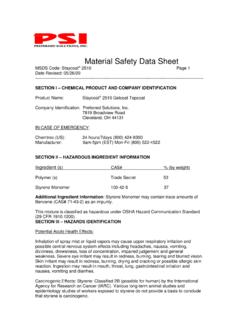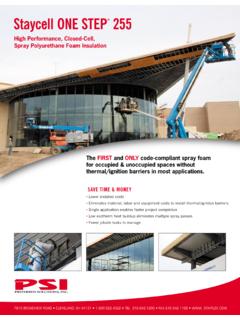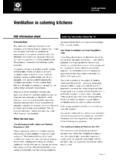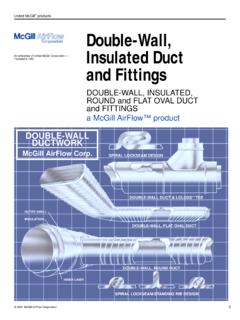Transcription of Technical Data Sheet - Stayflex
1 1 Technical data Sheet Staycell ONE STEP 255 Intumescent Spray Foam Insulation Staycell ONE STEP 255 is a two-part, closed-cell, intumescent, spray polyurethane foam product used to insulate roof decks, ceilings, walls, siding or structural steel and to provide an integral air barrier / insulation / vapor retarder for building envelope assemblies. This product has Class A/Class 1 flame spread and smoke developed ratings and qualifies as an Alternative Thermal Barrier Assembly when installed exposed without thermal barriers, ignition barriers or other fire protective surfaces in accordance with QAI Evaluation Report No. B1020-1, Edition 6. Benefits: Superior insulation performance compared to fiberglass or cellulose Controls air and moisture infiltration Strengthens roofs and walls Environmentally friendly. Utilizes EPA approved, zero-ozone depleting blowing agents Typical Physical Properties Nominal Density ASTM D1622, lbs/ft3 Thermal Resistance ASTM C518 Aged R value (140 F @ 90 days) Air Permeance ASTM E283 @ Water Vapor Permeance (perms) ASTM E96 @ Dimensional Stability ASTM D2126 ( 168 hr.)
2 At 70 C, 97% humidity) Closed Cell Content ASTM D6226 lbs. @ 1 inch .0014 cfm/ft2 3% 90% Compressive Strength ASTM D1621, psi Tensile Strength ASTM D1623, psi Surface Burning Characteristics ASTM E84 (4 thick) Flame Spread Index Smoke Developed Index UL 1715 Large-Scale, Room Fire Test* < 4 inches on walls only < 8 inches on undersides of ceilings or roofs only *For details, see Building Code Compliance NFPA 259 Potential Heat, per inch NFPA 285 Compliant for use in Building Types: I, II, III, IV, V 22 28 <25 <450 Pass 1,835 Btu/ft2 Pass Building Code Compliance As shown below, Staycell ONE STEP 255 is listed, labeled and certified by QAI Laboratories ( ) indicating Class A/Class 1 flame spread and smoke developed ratings per ASTM E-84 as required by the 2003, 2006, 2009, 2012 and 2015 editions of the International Building Code (IBC) and International Residential Code (IRC) and qualifies as an Alternative Thermal Barrier Assembly when installed exposed without thermal 2 barriers, ignition barriers or other fire protective surfaces in accordance with QAI Evaluation Report No.
3 B1020-1, Edition 6. Fire testing of the exposed Staycell ONE STEP 255 was conducted separately for installation on either walls only or the underside of ceilings/roofs only. THIS PRODUCT IS NOT TO BE INSTALLED EXPOSED ON ENTIRE WALLS AND ENTIRE ROOF/CEILINGS WHEN ADJACENT TO EACH OTHER. Contact PSI for tested wall/roof transitions for air sealing applications. US Staycell ONE STEP 255 Intumescent Spray Foam Insulation Fire performance in accordance with ASTM E-84*: Tested thickness: 4 inches Flame spread index: <25 Smoke developed index: <450 Alternative Thermal Barrier Assembly when installed exposed; no thermal barrier or ignition barrier required based on compliance with UL1715 large-scale, room fire test: Exposed applications on walls only: Nominal 4 inch or less thickness Exposed applications on undersides of roofs/ceilings only: Nominal 8 inch or less thickness * These fire ratings are not intended to reflect the hazards of these products under all actual fire conditions.
4 Contact the Authority Having Jurisdiction (AHJ) for additional or specific building code requirements prior to beginning any project. QAI is accredited by International Accreditation Services, Inc. (IAS) of the International Code Council for fire testing, quality control inspections of manufacturing facilities and certification of listed and labeled products in accordance with IAS Registration Nos. AA-723, TL-220 and PCA-119. Storage Both components should be stored in their original containers and away from excessive heat and moisture, especially after the seals have been broken or some materials have been used. Drums should be stored indoors and maintained between 50 -75 F. Containers should be opened carefully to allow any pressure buildup to be vented safely while wearing full safety protection.
5 Excessive venting of Part B component may result in higher density foam and reduced yield. Materials stored at temperatures below 50 F will increase viscosity and some application equipment may not reach adequate spray temperature set points. Supply pumps and hoses must be sized to provide adequate supply when materials are cold and at a higher viscosity. Shelf Life Shelf life of Part A and Part B components is six months when stored in the original, unopened containers at 50 -75 F. Shelf life may decrease if storage is above or below these temperatures. Surface Preparation All surfaces to receive Staycell ONE STEP 255 must be clean and dry, free of dirt, oil, solvent, grease, loose particulates, curing compounds, frost, ice and other foreign matter which could inhibit adhesion. Moisture content and surface conditions of substrate are critical to adhesion and need to be verified by installing contractor in small test areas before proceeding with full application.
6 Prime if necessary. Evaluation Report No. B1020-1, Edition 6 3 Suitable substrates include: exterior grade gypsum sheathing, OSB, plywood, lumber, CMU, structural and lightweight concrete and galvanized, aluminum and painted metal. Lightweight insulating concrete or other friable substrates are not recommended. Recommended Substrate Temperatures Minimum substrate & air temp: 40 F Maximum substrate & air temp: 120 F For applications below 40 F., contact PSI Technical Services for Cold Temperature Application Guidelines. Climatic Conditions and Humidity Moisture in the form of rain, dew and frost can seriously affect the quality and adhesion of the Staycell ONE STEP 255 to the substrate or itself. When heating the interior of a building in cold weather, humidity can change dramatically and substrates should be constantly measured for moisture/condensation.
7 Application Equipment The proportioning equipment shall be manufactured specifically for heating, mixing, and spraying of polyurethane foam and be able to maintain 1:1 volume metering with a + 2% variance and adequate heating capacity to deliver heated and pressurized materials up to 130 F. Heated hose must be able to maintain pre-set temperatures for the full length of the hose. Minimum 2:1 pressure ratio feeder pumps are required to supply stored materials through minimum 3/4" supply hoses. Processing Temperatures Recommended processing temperatures: Main heaters on proportioner: 120-130 F for Part A, Part B and hose. These are critical settings to achieve viscosity necessary for balanced pressures during spraying. Balanced chemical output pressures are important for producing good mix. Foam output pressures greater than 200 psi differential indicate either improper chemical temperatures or worn gun/packing parts.
8 Unequal pressures will cause poor chemical mixing during spraying and uneven backpressure. A critical requirement for good spray mixing requires appropriate tip/module sizing for the proportioner and adequate heating capacity. Unequal pressures greater than 200 psi can cause excessive pump wear. Do not re-circulate Part B component to increase temperature as frothing or boil-over may occur at material temperatures above 60 F. Spraying Thin, (1/4 inch or less) flash passes to very cold surfaces should be avoided since reduced yield and loss of adhesion may occur. It is recommended that the total design thickness be completed each day. This spray system should be applied in uniform, minimum pass thickness of and maximum pass thickness of four inches. Application temperatures below 40 F may require reduction in single pass application thickness.
9 Yield and in-place density are dependent upon the temperature of the substrate, ambient air temperature, speed of application, gun tip size, and the output of the proportioning unit. Excessive pass thickness can reduce density and physical properties and cause local overheating and possible fire. To avoid heat damage when applying over membranes (such as Blueskin SA), apply initial one-inch pass and allow to fully cool before subsequent passes. Drums must be agitated prior to use. For detailed installation information, please refer to the Staycell ONE STEP 255 Installation Guide. Worker Exposure Hazards Both Components A and B can cause severe inhalation and skin sensitization. For interior applications, full body protection is recommended including an air-supplied respirator such as a self-contained breathing apparatus (SCBA) or a supplied air respirator (SAR) in the positive pressure or continuous flow mode (this includes air supplied hoods).
10 Alternatively, a full-face air purifying respirator with suitable organic vapor/particulate filter combination cartridge (OV/P100) may be worn. Product information and training materials can be obtained from PSI at , the Spray Polyurethane Foam Alliance and the Center for the Polyurethane Industry websites , and 4 Precautions Read and understand the Safety data Sheets for this product before use. Each firm, person, and organization engaged in the use or application of this product should carefully examine the end use to determine any potential fire hazard associated with its use and utilize appropriate precautionary and safety measures. Consult with local building code officials and insurance agency personnel before application. Caution during application must be observed with signs posted for other trades reading Caution: Combustible Insulation, No Welding or Hot Work Allowed.










